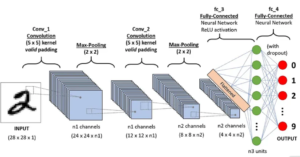Convolutional Neural Networks (CNNs) are a powerful type of deep learning model specifically designed for processing grid-like data like images. Their ability to automatically learn and extract complex features from images has made them the dominant architecture for various computer vision tasks, including:
- Image recognition: Identifying objects, scenes, and activities in images.
- Object detection: Localizing and recognizing objects in images.
- Image segmentation: Segmenting an image into different regions corresponding to different objects or categories.
- Medical image analysis: Detecting diseases and abnormalities in medical images.
- Self-driving cars: Recognizing objects and navigating in road environments.
Architecture of CNNs
Unlike traditional neural networks, CNNs have a unique architecture composed of specialized layers that work together to effectively extract features from images. Here are the key components:
1. Convolutional Layers:
- The core building block of CNNs, consisting of filters that slide across the input image and perform dot products with local regions of the image.

- These filters learn to detect specific features, like edges, lines, and textures.
- The output of a convolutional layer is called a feature map.
2. Pooling Layers:
- Downsample the input by summarizing the information within local regions.
- This reduces the dimensionality of the data and helps to control overfitting.
- Common pooling strategies include max pooling and average pooling.
3. Activation Functions:
- Introduce non-linearity to the network, allowing it to learn complex patterns.
- Popular activation functions for CNNs include ReLU and Leaky ReLU.
4. Fully Connected Layers:
- Similar to traditional neural networks, these layers receive flattened outputs from the convolutional layers and perform classifications or regressions.
Advantages of CNNs
- Feature learning: Automatically learn relevant features from the data, eliminating the need for manual feature engineering.
- High accuracy: Achieve remarkable performance on various image-related tasks.
- Scalability: Handle large and complex datasets efficiently.
- Transfer learning: Pre-trained CNN models can be fine-tuned for new tasks, reducing training time and improving performance.
Applications of CNNs
CNNs have diverse applications across various industries and domains, including:
- Healthcare: Analyze medical images for disease detection, diagnosis, and treatment planning.
- Retail: Recommend products to customers based on their past purchases and browsing history.
- Security: Detect suspicious activities in video surveillance footage.
- Agriculture: Monitor crop health and predict yield.
- Robotics: Enable robots to perceive and interact with their environment.
Challenges of CNNs
- High computational cost: Training CNNs requires significant computational resources and can be time-consuming.
- Overfitting: Like any deep learning model, CNNs are susceptible to overfitting, especially when dealing with small datasets.
- Interpretability: Understanding how CNNs make decisions can be difficult due to their complex architecture.
Conclusion
CNNs are powerful tools that have revolutionized the field of computer vision. Their ability to learn complex features from images has led to significant advancements in various applications. By understanding their architecture, advantages, and challenges, you can leverage the power of CNNs to solve challenging problems across diverse domains.
